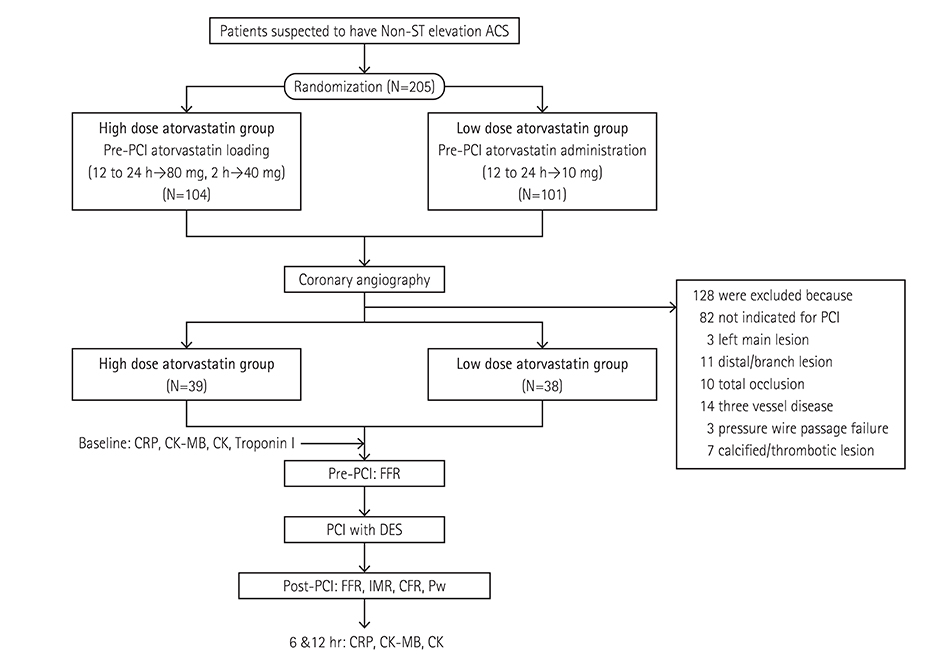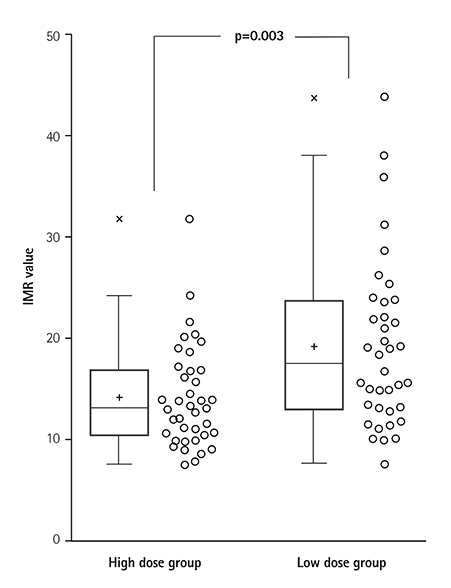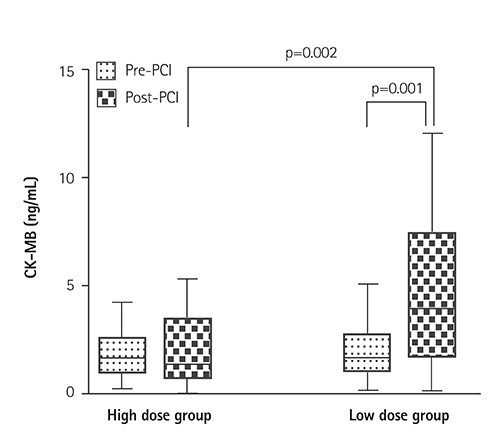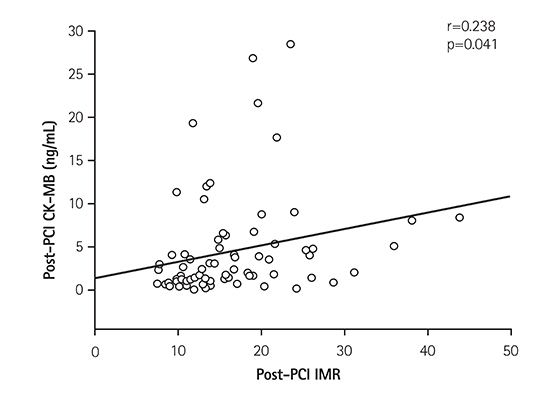Korean Circ J.
2016 Jul;46(4):472-480. 10.4070/kcj.2016.46.4.472.
Does Pre-Treatment with High Dose Atorvastatin Prevent Microvascular Dysfunction after Percutaneous Coronary Intervention in Patients with Acute Coronary Syndrome?
- Affiliations
-
- 1Division of Cardiology, Kangwon National University School of Medicine, Chuncheon, Korea.
- 2Division of Cardiology, Seoul National University Hospital, Seoul, Korea. bkkoo@snu.ac.kr
- 3Division of Cardiology, Keimyung University Dongsan Medical Center, Daegu, Korea.
- 4Division of Cardiology, Inje University Ilsan-Paik Hospital, Goyang, Korea.
- 5Division of Cardiology, Seoul National University Boramae Medical Center, Seoul, Korea.
- 6Department of Cardiovascular Medicine, Stanford University Medical Center, Stanford, CA, USA.
- KMID: 2344421
- DOI: http://doi.org/10.4070/kcj.2016.46.4.472
Abstract
- BACKGROUND AND OBJECTIVES
There is controversy surrounding whether or not high dose statin administration before percutaneous coronary intervention (PCI) decreases peri-procedural microvascular injury. We performed a prospective randomized study to investigate the mechanisms and effects of pre-treatment high dose atorvastatin on myocardial damage in patients with non-ST-segment elevation acute coronary syndrome (NSTE-ACS) undergoing PCI.
SUBJECTS AND METHODS
Seventy seven patients with NSTE-ACS were randomly assigned to either the high dose group (atorvastatin 80 mg loading 12 to 24 h before PCI with a further 40 mg loading 2 h before PCI, n=39) or low dose group (atorvastatin 10 mg administration 12 to 24 h before PCI, n=38). Index of microcirculatory resistance (IMR) was measured after stent implantation. Creatine kinase-myocardial band (CK-MB) and high sensitivity C-reactive protein (CRP) levels were measured before and after PCI.
RESULTS
The baseline characteristics were not different between the two patient groups. Compared to the low dose group, the high dose group had lower post PCI IMR (14.1±5.0 vs. 19.2±9.3 U, p=0.003). Post PCI CK-MB was also lower in the high dose group (median: 1.40 ng/mL (interquartile range [IQR: 0.75 to 3.45] vs. 4.00 [IQR: 1.70 to 7.37], p=0.002) as was the post-PCI CRP level (0.09 mg/dL [IQR: 0.04 to 0.16] vs. 0.22 [IQR: 0.08 to 0.60], p=0.001).
CONCLUSION
Pre-treatment with high dose atorvastatin reduces peri-PCI microvascular dysfunction verified by post-PCI IMR and exerts an immediate anti-inflammatory effect in patients with NSTE-ACS.
Keyword
MeSH Terms
Figure
Cited by 1 articles
-
Lipid-Core Plaque Assessed by Near-Infrared Spectroscopy and Procedure Related Microvascular Injury
Hyoung-Mo Yang, Myeong-Ho Yoon, Hong-Seok Lim, Kyoung-Woo Seo, Byoung-Joo Choi, So-Yeon Choi, Gyo-Seung Hwang, Seung-Jea Tahk
Korean Circ J. 2019;49(11):1010-1018. doi: 10.4070/kcj.2019.0072.
Reference
-
1. Levine GN, Bates ER, Blankenship JC, et al. 2011 ACCF/AHA/SCAI Guideline for Percutaneous Coronary Intervention. A report of the American College of Cardiology Foundation/American Heart Association Task Force on Practice Guidelines and the Society for Cardiovascular Angiography and Interventions. J Am Coll Cardiol. 2011; 58:e44–e122.2. Prasad A, Singh M, Lerman A, Lennon RJ, Holmes DR Jr, Rihal CS. Isolated elevation in troponin T after percutaneous coronary intervention is associated with higher long-term mortality. J Am Coll Cardiol. 2006; 48:1765–1770.3. Fuchs S, Kornowski R, Mehran R, et al. Prognostic value of cardiac troponin-I levels following catheter-based coronary interventions. Am J Cardiol. 2000; 85:1077–1082.4. Patti G, Pasceri V, Colonna G, et al. Atorvastatin pretreatment improves outcomes in patients with acute coronary syndromes undergoing early percutaneous coronary intervention: results of the ARMYDA-ACS randomized trial. J Am Coll Cardiol. 2007; 49:1272–1278.5. Briguori C, Visconti G, Focaccio A, et al. Novel approaches for preventing or limiting events (Naples) II trial: impact of a single high loading dose of atorvastatin on periprocedural myocardial infarction. J Am Coll Cardiol. 2009; 54:2157–2163.6. Jang Y, Zhu J, Ge J, Kim YJ, Ji C, Lam W. Preloading with atorvastatin before percutaneous coronary intervention in statin-naïve Asian patients with non-ST elevation acute coronary syndromes: a randomized study. J Cardiol. 2014; 63:335–343.7. Veselka J, Zemánek D, Hájek P, et al. Effect of two-day atorvastatin pretreatment on long-term outcome of patients with stable angina pectoris undergoing elective percutaneous coronary intervention. Am J Cardiol. 2011; 107:1295–1299.8. Zemánek D, Branny M, Martinkovičová L, et al. Effect of seven-day atorvastatin pretreatment on the incidence of periprocedural myocardial infarction following percutaneous coronary intervention in patients receiving long-term statin therapy. A randomized study. Int J Cardiol. 2013; 168:2494–2497.9. Fearon WF, Balsam LB, Farouque HM, et al. Novel index for invasively assessing the coronary microcirculation. Circulation. 2003; 107:3129–3132.10. Fearon WF, Low AF, Yong AS, et al. Prognostic value of the index of microcirculatory resistance measured after primary percutaneous coronary intervention. Circulation. 2013; 127:2436–2441.11. Patti G, Colonna G, Pasceri V, Pepe LL, Montinaro A, Di Sciascio G. Randomized trial of high loading dose of clopidogrel for reduction of periprocedural myocardial infarction in patients undergoing coronary intervention: results from the ARMYDA-2 (Antiplatelet therapy for Reduction of MYocardial Damage during Angioplasty) study. Circulation. 2005; 111:2099–2106.12. Fearon WF, Nakamura M, Lee DP, et al. Simultaneous assessment of fractional and coronary flow reserves in cardiac transplant recipients: Physiologic Investigation for Transplant Arteriopathy (PITA Study). Circulation. 2003; 108:1605–1610.13. Aarnoudse W, Fearon WF, Manoharan G, et al. Epicardial stenosis severity does not affect minimal microcirculatory resistance. Circulation. 2004; 110:2137–2142.14. Fearon WF, Shah M, Ng M, et al. Predictive value of the index of microcirculatory resistance in patients with ST-segment elevation myocardial infarction. J Am Coll Cardiol. 2008; 51:560–565.15. Melikian N, Vercauteren S, Fearon WF, et al. Quantitative assessment of coronary microvascular function in patients with and without epicardial atherosclerosis. EuroIntervention. 2010; 5:939–945.16. Lee BK, Lim HS, Fearon WF, et al. Invasive evaluation of patients with angina in the absence of obstructive coronary artery disease. Circulation. 2015; 131:1054–1060.17. Gibson CM, Murphy SA, Marble SJ, et al. Relationship of creatine kinase-myocardial band release to Thrombolysis in Myocardial Infarction perfusion grade after intracoronary stent placement: an ESPRIT substudy. Am Heart J. 2002; 143:106–110.18. Bolognese L, Ducci K, Angioli P, et al. Elevations in troponin I after percutaneous coronary interventions are associated with abnormal tissue-level perfusion in high-risk patients with non-ST-segment-elevation acute coronary syndromes. Circulation. 2004; 110:1592–1597.19. Ng MK, Yeung AC, Fearon WF. Invasive assessment of the coronary microcirculation: superior reproducibility and less hemodynamic dependence of index of microcirculatory resistance compared with coronary flow reserve. Circulation. 2006; 113:2054–2061.20. Pepine CJ, Anderson RD, Sharaf BL, et al. Coronary microvascular reactivity to adenosine predicts adverse outcome in women evaluated for suspected ischemia results from the National Heart, Lung and Blood Institute WISE (Women's Ischemia Syndrome Evaluation) study. J Am Coll Cardiol. 2010; 55:2825–2832.21. Herrmann J. Peri-procedural myocardial injury: 2005 update. Eur Heart J. 2005; 26:2493–2519.22. Prasad A, Herrmann J. Myocardial infarction due to percutaneous coronary intervention. N Engl J Med. 2011; 364:453–464.23. Cannon CP, Braunwald E, McCabe CH, et al. Intensive versus moderate lipid lowering with statins after acute coronary syndromes. N Engl J Med. 2004; 350:1495–1504.24. Schwartz GG, Olsson AG, Ezekowitz MD, et al. Effects of atorvastatin on early recurrent ischemic events in acute coronary syndromes: the MIRACL study: a randomized controlled trial. JAMA. 2001; 285:1711–1718.25. Takemoto M, Liao JK. Pleiotropic effects of 3-hydroxy-3-methylglutaryl coenzyme a reductase inhibitors. Arterioscler Thromb Vasc Biol. 2001; 21:1712–1719.26. Joshi MS, Tong L, Cook AC, et al. Increased myocardial prevalence of C-reactive protein in human coronary heart disease: direct effects on microvessel density and endothelial cell survival. Cardiovasc Pathol. 2012; 21:428–435.27. Ahmed K, Jeong MH, Chakraborty R, et al. Prognostic impact of baseline high-sensitivity C-reactive protein in patients with acute myocardial infarction undergoing percutaneous coronary intervention based on body mass index. Korean Circ J. 2012; 42:164–172.28. Patti G, Mangiacapra F, Ricottini E, et al. Correlation of platelet reactivity and C-reactive protein levels to occurrence of peri-procedural myocardial infarction in patients undergoing percutaneous coronary intervention (from the ARMYDA-CRP study). Am J Cardiol. 2013; 111:1739–1744.29. Correia LC, Spósito AC, Lima JC, et al. Anti-inflammatory effect of atorvastatin (80 mg) in unstable angina pectoris and non-Q-wave acute myocardial infarction. Am J Cardiol. 2003; 92:298–301.30. Kinlay S, Schwartz GG, Olsson AG, et al. High-dose atorvastatin enhances the decline in inflammatory markers in patients with acute coronary syndromes in the MIRACL study. Circulation. 2003; 108:1560–1566.
- Full Text Links
- Actions
-
Cited
- CITED
-
- Close
- Share
- Similar articles
-
- Recent Advances in Percutaneous Coronary Intervention in Coronary Artery Disease
- Staged versus One-Time Percutaneous Coronary Intervention Strategy for Multivessel Non-ST Segment Elevation Acute Coronary Syndrome
- Antiplatelet Agents in High-Risk Patients with Coronary Artery Disease
- Diabetes Mellitus and Coronary Angiography
- Spontaneous coronary artery dissection by intravascular ultrasound in a patient with myocardial infarction





